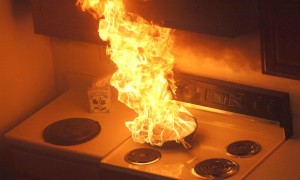Fire safety is critical for every homeowner because in a matter of minutes, your home could be destroyed by a fire and, even worse, the loss of life could occur. How safe is your home from a fire and what measures have you taken to be alerted in the event of a fire? How quickly will you know if a fire occurs, no matter your location in the home?
As a real estate professional, I feel that my job is to inform all homeowners of the importance of fire safety. I am fortunate to personally know Ed Pfeiffer, the Fire Marshal in Warwick Township located in Bucks County, Pennsylvania. He is an advocate of fire safety and has educated me on fire safety. I have compiled a list of suggestions and checklist with Ed’s input.
New Technology for Older Homes WHY?

Residential fire safety has been reduced to these two questions. If you can honestly answer them, you have a fire safe home. If you can’t, your family is at some risk for an undetected fire.
1. Can you hear all of your smoke detectors from anywhere in your home — especially from your bedroom when you are asleep?
2. Do you have enough detectors to sense the earliest presence of smoke everywhere in your home?
Everyone who has been injured, burned, or died in a residential fire was home at the time the fire began. Had they known of the early presence of smoke, they could have escaped. They may have had time to take action to prevent the smoke from developing into a fire.
Where?
“Coverage” is a term most associated with sprinkler systems. Applying “coverage” to smoke detectors will require a smoke detector in every room in the house with a door. No matter where you are in your home day or night you need to know if there is smoke in another area of the house. Today’s International Building Code requires a detector in each bedroom, outside the bedrooms, and on each level. A house with “coverage” would have a detector in every room with a door, except closets and bathrooms.
Open areas may only require one detector. Example: The first floor of a typical home includes a kitchen, dining room, and living room — all with a common ceiling with no doors between rooms. If a detector is present on the second floor at the top of the stairs, it will cover the three first floor rooms. A single detector at the top of the basement stairs (assuming there are no separate basement rooms) will cover the entire basement. A detector in each bedroom and the garage will require seven interconnected detectors in an average three-bedroom home.

How?
- Purchase Kidde or similar “Wireless Interconnected Smoke Detectors.”
- Remove all the detectors from their boxes and separate all the individual components (all batteries together, all anchors and screws together, etc.).
- Set the eight position “DIP” switch to any combination (of up or down), as long as that combination is the same for all of your detectors.
- Install batteries in all detectors. Note proper positions.
- Place all the detectors on a table and push and hold the test button until all the red lights are flashing.
- Mount the detectors on the ceiling at least 12 inches from any wall. Place the basement detector at the top of the stairs. The garage detector should be mounted several feet from the wall, near the door to the home.
BE SAFE!
Main Image Source: Flickr/James Case
[cf]skyword_tracking_tag[/cf]







Frank,
Good basic information for homeowners who want to bring their older home up to the standards of the current building code. “Wireless Interconnected Smoke Detectors” allow homes to be upgraded without the need for wires. They are battery powered and easily installed by the homeowner. Many fires begin when someone is home and don’t know there is smoke in the house until it is too late. Stories of actual fires incidents can be read on the website BUCKSCOUNTYFIRESAFEHOMES.COM.
Great information.
Ed
Frank
Very good information to have both for an existing home owner and one looking to buy a new home. Love the wireless concept of smoke detectors.
Thank you for this resource.
Bill
Bill,
Thanks for your response! So many people die in fires when in most cases they could be prevented. Some education and things like changing batteries yearly and most of all, making certain that smoke detectors are in line and communicate. I go into many houses on a daily basis and I see alarms disconnected because they make noise or don’t work. What many homeowners do not realize is that for as little as a dollar or as much as $12-$30 can save their lives.